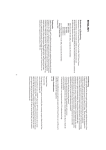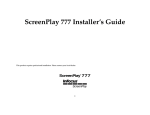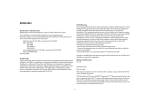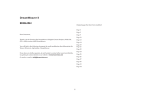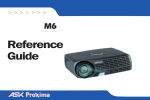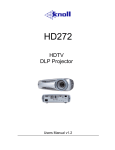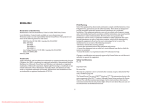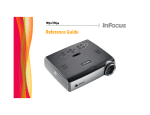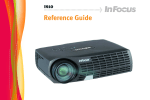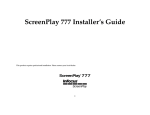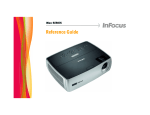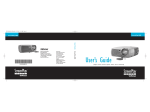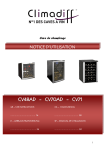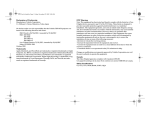Download User Manual - Projector Central
Transcript
ENGLISH FCC Warning Note: This equipment has been tested and found to comply with the limits for a Class B digital device, pursuant to part 15 of the FCC Rules. These limits are designed to provide reasonable protection against harmful interference in a residential installation. This equipment generates, uses and can radiate radio frequency energy and, if not installed and used in accordance with the instructions, may cause harmful interference to radio communications. However, there is no guarantee that interference will not occur in a particular installation. If this equipment does cause harmful interference to radio or television reception, which can be determined by turning the equipment off and on, the user is encouraged to try to correct the interference by one or more of the following measures: --Reorient or relocate the receiving antenna. --Increase the separation between the equipment and receiver. --Connect the equipment into an outlet on a circuit different from that to which the receiver is connected. --Consult the dealer or an experienced radio/TV technician for help. Declaration of Conformity Manufacturer: InFocus Corporation, 27700B SW Parkway Ave. Wilsonville, Oregon 97070 USA European Office: Strawinskylaan 585, 1077 XX Amsterdam, The Netherlands We declare under our sole responsibility that the ScreenPlay 5700 projector conforms to the following directives and norms: EMC Directive 89/336/EEC, Amended by 93/68/EEC EMC: EN 55022 EN 55024 EN 61000-3-2 EN 61000-3-3 Low Voltage Directive 73/23/EEC, Amended by 93/68/EEC Safety: EN 60950: 2000 May, 2003 Changes or modifications not expressly approved by InFocus Corporation can void the user's authority to operate the equipment. Canada Trademarks This Class B digital apparatus complies with Canadian ICES-003. Cet appareil numérique de la classe B est conforme à la norme NMB-003 du Canada. Apple, Macintosh, and PowerBook are trademarks or registered trademarks of Apple Computer, Inc. IBM is a trademark or registered trademark of International Business Machines, Inc. Microsoft, PowerPoint, and Windows are trademarks or registered trademarks of Microsoft Corporation. Digital Light Processing is a trademark or registered trademark of Texas Instruments. Faroudja, DCDi, and TrueLife are trademarks or registered trademarks of Faroudja. InFocus and ScreenPlay are trademarks or registered trademarks of InFocus Corporation. Agency Approvals UL, CUL, TÜV, NOM, IRAM, GOST, CCC, MIC, C-Tick 1 For complete details on connecting and operating the projector, refer to this User’s Guide. Electronic versions of this User’s Guide in multiple languages are available on our website at www.infocushome.com/support. Table of Contents Introduction Positioning the projector Video connections Connecting a video device Displaying a video image Connecting a computer Shutting down the projector Troubleshooting your setup Using the keypad buttons Using the remote control Optimizing video images Customizing the projector Using the menus Picture menu Settings menu Maintenance Cleaning the lens Replacing the projection lamp Appendix Specifications Accessories Red LED behavior and projector errors Projected image size Source compatibility Projector dimensions for ceiling mount installations RS-232 terminal specifications 3 5 6 7 8 10 11 11 18 19 20 20 21 22 27 29 29 30 32 32 32 33 33 34 35 36 The website also has technical specifications (an interactive image size calculator, laptop activation commands, connector pin outs, a glossary, the product data sheet), a web store to buy accessories, and a page for online registration. Important Operating Considerations Do not place the projector on a tablecloth or other soft covering that may block the vents. Vents are placed along the left and right sides of the projector, as well as across the front of the projector. Do not use a non-approved ceiling mount. In the unlikely event of the lamp rupturing, discard any edible items placed in the surrounding area and thoroughly clean the area along the sides and in the front of the projector. Do not place objects in the areas along the side and in the front of the projector 2 ft (.6m) 2 ft (.6m) 2 ft (.6m) 2 Projector components and features Introduction keypad Congratulations and thank you for your excellent choice of a superior digital image projection device. Your new ScreenPlay™ 5700 projector from InFocus® is specifically designed for home cinema applications. The ScreenPlay 5700 sets the standard for Enhanced-Definition digital perfection, featuring true Enhanced Definition 1024x576 resolution using the latest DLP™ technology and new DCDi video processing from Faroudja™. Calibrated to D65 color mastering standards, the ScreenPlay 5700 reproduces colors and details the way the director intended. Whether you are watching movies or High Definition broadcasts or playing the latest video game, you will enjoy breathtaking image quality. remote control receiver (IR) IR air intake vent elevator foot release focus Online Registration Register your projector online at www.infocus.com/service/register to receive product updates, announcements, and registration incentives. zoom heat vent I/O panel Included items cable cover remote control receiver (IR) projector leveling foot lens cap SCART cable user’s guide, safety card remote power cable* *country-dependent 3 IR exhaust Connector Panel The projector provides eight discreet video connectors: • two component RCA • two S-video • one composite RCA • one M1-DA (HD, DVI, and computer) • one VESA (HD, HD component, and computer) • IR input video/computer 1&2 s-video 1 Y M1-DA 1 IR in vesa 2 Pr 3 component one component D5 power connector Two 3.5 mm mini-jack triggers provide 12 volt current. Trigger 1 provides a constant output while the projector is on. If you connect your projection screen to Trigger 1, when you turn on the projector the screen will move down; when you turn the projector off, the screen will return to the storage position. Trigger 2 provides a 4:3 aspect trigger. When you select 4:3 in the Aspect Ratio menu or from the Resize button on the remote, a 12v signal will be sent after a three second delay. Use this trigger for screens with 4:3 aspect curtains. When you switch back to 16:9 format, the curtains open to reveal the entire screen. 2 Pb serial control It also has a mini-jack input for a Niles or Xantech-compatible IR repeater and an RS-232 connector for serial control. The Command Line Interface (CLI) specifications and commands are listed in the Appendix starting on page 36. D5 video video serial connector 4 5 s-video remote control receiver (IR) 12v triggers Y Pb 7 video Pr D5 8 trigger 1 trigger 2 6 component component video lock screen trigger connection +12v ground 3.5mm mono plug For details on each connector type and their inputs, see page 34. to screen relay (see screen manufacturer for details) 4 Positioning the projector There are a number a factors to consider when determining where to set up the projector, including the size and shape of your screen, the location of your power outlets, and the distance between the projector and the rest of your equipment. Here are some general guidelines. 1 Position the projector on a flat surface at a right angle to the screen. The projector must be within 10 feet (3 m) of your power source. To ensure adequate cable access, place the projector at least 6 inches (0.15m) from a wall or other objects. Place the projector at least 5.6 feet (1.7 m) from the projection screen. If you install the projector on the ceiling, refer to the installation guide that comes with the Ceiling Mount Kit for more information. To turn the image upside down, see page 27. InFocus recommends use of an authorized InFocus ceiling mount. The Ceiling Mount Kit is sold separately, see page 32. 10’ high image 2 Position the projector the desired distance from the screen. The distance from the lens of the projector to the screen, the zoom setting, and the video format determine the size of the projected image. For more information about projected image sizes, see page 33. The image exits the projector at a given angle. This image offset is 133%. This means that if you have an image 10’ high, the bottom of the image will be 3.3’ above the center of the lens. bottom of image 3.3’ above lens Go to www.infocushome.com/support for a complete image size calculator. 5 lens center Video connections M1-DA You can connect VCRs, DVD players, camcorders, digital cameras, video games, HDTV receivers, and TV tuners to the projector. (You cannot directly connect the coaxial cable that enters your house from a cable or satellite company; the signal must pass through a tuner first. Examples of tuners are digital cable boxes, VCRs, digital video recorders, and satellite TV boxes. Basically, any device that can change channels is considered a tuner.) Audio must be provided by your own speakers, as the projector has no separate audio controls. If there is more than one output, select the highest quality one. DVI, Component video and RGB (M1, HD15) have the best quality, followed by S-video, and then composite video. VESA 1 Y M1-DA 1 IR in vesa 2 serial control video s-video 2 Pb Pr 3 component 4 5 s-video Y Pb 7 video Pr D5 8 trigger 1 trigger 2 6 component component video Table 1: Video connections For a complete list of compatible sources, see page 34 of the Appendix. Input signal Connector Connector label on projector Standard Broadcast TV (not HDTV), via cable, digital cable, satellite TV, DirectTV Component video S-video Composite video Component 3, 6 S-video 4, 5 Video 7 HDTV Component video VESA DVI Component 3, 6 VESA 2 M1-DA 1 DVD Component video S-video Composite video Component 3, 6 S-video 4, 5 Video 7 VCR Composite video S-video Component video Video 7 S-video 4, 5 Component 3, 6 Video Camera Composite video S-video Video 7 S-video 4, 5 Video Game VESA Composite video S-video Component video VESA 2 Video 7 S-video 4, 5 Component 3, 6 6 Connecting a video device connect component cable If your video device has more than one output, select the highest quality one. DVI video has the best quality, followed by Component video, S-video, and then composite video. If the video device uses component cable connectors, plug the cable’s green connectors into the green component-out connector on the video device and into the green component connector (labeled “Y”) on the projector. Plug the component cable’s blue connectors into the blue component-out connector on the video device and into the blue component connector (labeled “Pb”) on the projector. Plug the component cable’s red connectors into the red component-out connector on the video device and into the red component connector (labeled “Pr”) on the projector. If the video device uses a round, four-prong S-video connector, plug an S-video cable into the S-video connector on the video device and into the Svideo connector on the projector. If the video device uses a yellow composite video connector, plug a composite video cable’s yellow connector into the video-out connector on the video device. Plug the other yellow connector into the yellow Video connector on the projector. 1 Y IR in M1-DA 1 vesa 2 Y 2 Pb Pr serial control trigger 2 Pr 6 component connect S-video cable 1 Y IR in M1-DA 1 trigger 1 D5 8 7 video Pb 4 5 s-video 3 component vesa 2 Y 2 Pb Pr serial control Pb 3 component trigger 1 D5 8 7 video trigger 2 Pr 4 5 s-video 6 component connect composite video cable 1 Y IR in M1-DA 1 vesa 2 Pr 3 component connect M1-D cable vesa 2 Pr 3 component connect VESA cable IR in vesa 2 serial control Connecting the power cable 1 Y M1-DA 1 IR in vesa 2 serial control Connect the power cable to the connector on the back of the projector and to your electrical outlet. The Power LED on the keypad turns solid green. NOTE: Always use the power cable that shipped with the projector. 7 2 Pb Pr 3 component 4 5 s-video Y Pb Pr 6 component 7 video D5 8 trigger 1 trigger 2 2 Pb Pr 3 component connect power cable 1 Y M1-DA 1 4 5 s-video 4 5 s-video Y 7 video Pb Pb 7 video D5 8 Pr 7 video trigger 1 trigger 2 6 component Y Pb 6 component D5 8 trigger 1 trigger 2 Pr 4 5 s-video D5 8 Pr 6 component Y 2 Pb serial control If the video device uses a VESA connector, plug a VESA cable into the video-out connector on the video device. Plug the other connector into the VESA connector on the projector. 1 Y IR in M1-DA 1 If the video device uses a DVI connector, plug an M1-D cable into the videoout connector on the video device. Plug the other connector into the M1-DA connector on the projector. 2 Pb serial control trigger 1 trigger 2 Displaying a video image remove lens cap Remove the lens cap. Press the Power button on the top of the projector. press Power The projector chimes if the chime feature is enabled (page 28). The LED flashes green and the fans start to run. When the lamp comes on, the startup screen displays and the LED is steady green. It can take a minute for the image to achieve full brightness. ? No startup screen? Get help on page 12. Plug in and turn on the video device. turn on video device An image from the video device should appear on the projection screen. If it doesn’t, press the Source button on the keypad. Adjust the height of the projector by pressing the release button to extend the elevator foot. Rotate the leveling foot, if necessary. adjust height elevator foot Position the projector the desired distance from the screen at a 90 degree angle to the screen. See page 33 for a table listing screen projected image sizes and distances to the screen. adjust distance 8 rotate leveling foot Adjust the zoom or focus rings by rotating them until the desired image size and sharpness are produced. adjust zoom and focus zoom focus If the image is not square, adjust the keystone using the buttons on the keypad. Press the upper Keystone button to reduce the width of the upper portion of the image, and press the lower Keystone button to reduce the width of the lower portion. adjust keystone The Contrast, Brightness, Color, andTint are factory calibrated to D65 colors, but you can adjust these settings in the Picture menu if necessary. See page 21 for help with the menus. adjust Picture menu 9 Connecting a computer connect computer cable 1 Y IR in M1-DA 1 vesa 2 Y 2 Pb Pr serial control 7 video Pb D5 8 5 s-video trigger 1 trigger 2 Pr 4 3 component 6 component Connect either a VESA cable or M1 cable into the appropriate connector on the projector. Connect the other end to the video port on your computer. If you are using a desktop computer, you first need to disconnect the monitor cable from the computer’s video port. 1 Y M1-DA 1 IR in vesa 2 Pr 3 component Connect the power cable to the connector on the back of the projector and to your electrical outlet. 1 Y connect power cable M1-DA 1 IR in vesa 2 serial control Pr 3 component Pb 7 video D5 8 7 video D5 8 trigger 1 trigger 2 Pr 6 component trigger 1 trigger 2 Pr 4 5 s-video Pb 4 5 s-video Y 2 Pb Y 2 Pb serial control 6 component The Power LED on the projector’s keypad turns solid green. NOTE: Always use the power cable that shipped with the projector. Turn on the projector, then your computer. You can control the projector from an LCD control panel or computer by connecting an RS-232 cable to the projector’s Serial connector. Specific RS-232 commands can be found in the Appendix starting on page 37 and in the Service and Support section of our website at www.infocushome.com/ support. connect RS-232 cable 1 Y M1-DA 1 IR in vesa 2 serial control 10 2 Pb Pr 3 component 4 5 s-video Y Pb Pr 6 component 7 video D5 8 trigger 1 trigger 2 Shutting down the projector Troubleshooting your setup Power Save If your image appears correctly on the screen, skip to the next section (page 18). If it does not, troubleshoot the setup. The projector has a Power Save feature in the System menu that automatically turns the lamp off after no signals are detected for 20 minutes. After 10 additional minutes with no signal, the projector powers down. If an active signal is received before the projector powers down, the image is displayed. You must press the Power button to display an image after 30 minutes have passed. The LED on top of the projector’s keypad indicates the state of the projector and can help you troubleshoot. Table 2: LED behavior and meaning Turning off the projector To turn off the projector, press the Power button. The lamp turns off and the LED blinks green for about one minute while the fans continue to run to cool the lamp. When the lamp has cooled, the LED lights green and the fans stop. Unplug the power cable to completely power off the projector. LED color/behavior Meaning solid green The projector is plugged in, or the projector has been turned on and the software has initialized. The projector has been turned off and the fans have stopped. blinking green The Power button has been pressed and the software is initializing, or the projector is powering down and the fans are running to cool the lamp. blinking red The projector will not start up if the LED is blinking red. You must correct the problem, disconnect and reconnect the power cable, then power on the projector. A fan (blinks 4 times) or lamp (blinks 3 times) failure has occurred. Turn off the projector and wait one minute, then turn the projector on again. Also check for a blocked vent or a stopped fan (blinks 5 times). See page 33 for more information on blinking red LEDs. solid red An unidentifiable error: please contact Technical Support. The following table shows some potential problems. In some cases, more than one possible solution is provided. Try the solutions in the order they are presented. When the problem is solved, you can skip the additional solutions. 11 Problem Solution Result No startup screen Plug power cable in and remove lens cap press Power button Correct image Scre enPla Image not centered on screen Move projector, adjust zoom, adjust height zoom Adjust horizontal or vertical position in Picture>Advanced menu 12 Correct image y Image not square Adjust keystone on keypad Square image Image does not fit 16:9 screen Change aspect ratio to 16:9 in Picture>Aspect ratio menu Correct image Turn Overscan on in the Picture menu Edges of image distorted Correct image AB AB 13 1. Projected colors don’t match source 2. Colors are washed out or too deep 3. Image from component source appears greenish 1. Adjust color, tint, color temperature, brightness, or contrast in the menus. 2. Pick another gamma setting 3. Pick another color space COLOR COLOR Turn off Ceiling in Settings>System menu Image upside down BA Image reversed left to right Correct image Correct image AB Turn off Rear in Settings>System menu A Correct image AB 14 Video image “torn” and fragmented Change Video Standard in Picture>Advanced menu AB Lamp won’t turn on, LED blinking red (page 11) Correct image AB Make sure vents aren’t blocked; allow projector to cool for one minute Unplug projector; wait one minute; plug in projector and turn it on: lamp lights Scre enPla blinks red 15 y Computer-specific troubleshooting Press the Source button Activate laptop’s external port Only startup screen appears A Scre enPla y No computer image, just the words “Signal out of range” A Computer image projected A A or restart laptop Adjust computer refresh rate in Control Panel>Display>Settings>Advanced> Adapter (location varies by operating system) Signa l rang out of e 16 Computer image projected A A Image fuzzy or cropped AA A Set your computer’s display resolution to the native resolution of the projector (Start>Settings>Control Panel>Display>Settings tab, select 1024x576) Image clear and not cropped A For a laptop, disable laptop monitor or turn-on dualdisplay mode This product is backed by a limited two-year warranty. When sending the projector in for repair, we recommend shipping the unit in its original packing material, or having a professional packaging company pack the unit with all accessories for shipping. An optional ATA shipping case is available for purchase that provides adequate protection for shipping. Please insure your shipment for its full value. Still having problems? If you need assistance, call InFocus Customer Service directly at 1-800-799-9911. Support is free between 6 a.m. and 6 p.m. PST, Monday through Friday. Support is available in North America after hours and weekends for a fee at 1-888-592-6800. Or, send us an e-mail at [email protected]. In Europe, call InFocus in The Netherlands at (31) 20 579 2820. In Asia, call InFocus in Singapore at (65) 6334-9005. 17 Using the keypad buttons Most buttons are described in detail in other sections, but here is an overview of their functions: Power–turns the projector on (page 8) and off (page 8). Menu–opens the on-screen menus (page 21). Select–confirms choices made in the menus (page 21). menu navigation buttons Up/down arrows–navigates to and adjusts settings in the menus (page 21). Auto image–resynchs the projector to the source. Presets–cycles through the 3 available user preset settings (page 24). Keystone–adjusts squareness of the image (page 9 and page 22). Brightness–adjusts intensity of the image (page 22). Resize–changes the aspect ratio (page 22). Source–changes the active source (page 27). 18 Using the remote control backlight button The remote uses two (2) provided AAA batteries. They are easily installed by sliding the cover off the remote’s back, aligning the + and - ends of the batteries, sliding them into place, and then replacing the cover. navigation buttons To operate, point the remote at the projection screen or at the projector (not at the video device or computer). The range of optimum operation is 0 to 30 feet (9.14m). Press the remote’s Menu button to open the projector’s menu system. Use the arrow buttons to navigate, and the Select button to select features and adjust values in the menus. See page 21 for more info on the menus. The remote also has: • Power button to turn the projector on and off (see page 11 for shutdown info) • backlight button to light the remote’s buttons in the dark • Brightness and Contrast buttons to adjust the image • Blank button to display a blank screen instead of the current image (to change the color of the screen, see page 28) • Source buttons to switch among sources (to assign a particular source to a source button, see page 27) and a source toggle • Resize button to change the Aspect Ratio (see page 22) • Auto Image button to resynch the projector to the source • Preset button to restore stored settings (see page 24) • Overscan button to remove noise in a video image (page 24) Troubleshooting the remote • Make sure the batteries are installed in the proper orientation and are not dead. • Make sure you’re pointing the remote at the projector or the screen, not at the video device or the computer, and are within the remote range of 30 feet (9.14m). 19 Optimizing video images Customizing the projector After the video device is connected properly and the image is on the screen, you can optimize the image using the onscreen menus. For general information on using the menus, see page 21. You can customize the projector for your specific setup and needs. See page 27 to page 29 for details on these features. • For rear projection, turn Rear mode on in the Settings>System menu. • Change the Aspect ratio. Aspect ratio is the ratio of the image width to image height. TV screens are usually 1.33:1, also known as 4:3. HDTV and most DVDs are 1.78:1, or 16:9. Choose the option that best fits your input source in the menus, or press the Resize button on the remote to cycle through the options. See page 22. • For ceiling mounted projection, turn Ceiling mode on in the Settings>System menu. • Turn the projector’s display messages and power-on chime on and off. • Turn on power saving features. • Adjust the Keystone, Contrast, Brightness, Color, or Tint in the Picture menu. See page 22. • Specify blank screen colors and startup logos. Make the menus translucent. • Select a different Color Temperature or use the Color Control to adjust the gain and offset of the red, green, and blue color. See page 26. • Specify the menu language. • Select a specific Color Space or Gamma. See page 26. • Select a different Video Standard. Auto tries to determine the standard of the incoming video. Select a different standard if necessary. See page 26. • Turn overscan on to remove noise around the video image. See page 24. • Fine tune component inputs using the TrueLife™ adjustments. See page 25. • Tune colors to your specifications using Blue Only, Color Wheel Index, and ADC Calibration. See page 29. • Choose High Power to maximize the light output. See page 27. • Make sure your DVD player is set for a 16:9 television. See your DVD player’s user’s guide for instructions. 20 Using the menus To open the menus, press the menu button on the keypad or remote. (The menus automatically close after 60 seconds if no buttons are pressed.) The Main menu appears. Use the arrow buttons to move up and down to highlight the desired submenu, then press the Select button. Menu button To change a menu setting, highlight it, press Select, then use the up and down arrow buttons to adjust the value, select an option using radio buttons, or turn the feature on or off using check boxes. Press Select to confirm your changes. Use the arrows to navigate to another setting. When your adjustments are complete, navigate to Exit, then press Select to navigate to the previous menu; press the Menu button at any time to close the menus. Keypad navigation buttons Main menu Dots appear before the menu name. The number of dots indicate the menu’s level, ranging from one (the Main menu) to four (the most nested menus). Dots The menus are grouped by usage: • The Picture menu provides image adjustments. • The Settings menu provides set-up type adjustments that are not changed often. • The About menu provides a read-only display of information about the projector and source. Settings menu Picture menu Certain menu items may be hidden until a particular source is connected. For example, Tint is only available for NTSC video sources and will be hidden when other sources are active. Other menu items may be grayed out when they are not available. For example, Brightness is grayed out until an image is active. About menu 21 Picture menu To adjust the following five settings, highlight the setting, press Select, use the up and down arrows to adjust the values, then press select to confirm the changes. All menu defaults are listed in a table starting on page 37. increasing keystone Keystone: adjusts the image vertically and makes a squarer image. You can also adjust keystone from the keypad. Contrast: controls the degree of difference between the lightest and darkest parts of the picture and changes the amount of black and white in the image. Brightness: changes the intensity of the image. You can also adjust brightness from the keypad. Color: (video sources only) adjusts a video image from black and white to fully saturated color. Tint: (NTSC video sources only) adjusts the red-green color balance in the image. Aspect Ratio: Aspect ratio is the ratio of the image width to image height. TV screens are usually 1.33:1, also known as 4:3. HDTV and most DVDs are 1.78:1, or 16:9. You can choose Native, 4:3, 16:9, Letterbox, or Natural Wide. The default is 16:9. The goal is to show the most detail on the screen while preserving the ratio of width to height. The native resolution of the projector is 1024x576. Use Native, 4:3 or Naural Wide for 4:3 input sources; use Native, 16:9 or Letterbox for 16:9 input. Pressing the Resize button on the remote cycles through these options. Aspect ratio Native: this mode bypasses the internal scaler, displaying the image with no resizing. Since the native resolution is 1024x576 and 4x3 video images are approximately 640x480, 4x3 images will always be smaller than the display and will be centered in the display. Computer images 1024x768 or smaller will also be centered in the display. If a 16x9 video source or a 1280x1024 or larger computer source is viewed, it will display up to 1024 pixels and 576 lines from the center of the input. 22 decreasing keystone 16:9 image 16:9 image input 16:9 aspect ratio 9 9 16 16 4:3: resizes the image from its original version to fit a standard 4:3 aspect ratio screen. If you have a 4:3 source on a 16:9 screen, the image is placed in a 16:9 space, so black bars appear at the sides of the image. 4:3 aspect ratio 4:3 image on 16:9 screen 3 9 16 4 Letterbox: preserves the 16:9 aspect ratio. If you have a 16:9 source and screen, the image fills the screen. If your source is letterboxed, the image expanded to fill the screen. black bars 4:3 image input black bars 16:9: the default is 16:9, which preserves the 16:9 aspect ratio and is designed to be used with content that is Enhanced for Widescreen TVs. letterbox image input 16:9 image fills 16:9 screen black bars letterbox aspect ratio 9 3 black bars 4 16 4:3 image input Natural Wide: this mode stretches a 4:3 image to fill the entire 16:9 screen. The center two-thirds of the image is unchanged; the edges of the image are stretched. natural wide aspect ratio 3 9 4 23 4:3 image fills 16:9 screen 16 Presets: This allows you to customize settings and save the settings to be restored later. To restore the factory default settings, choose Factory Reset in the Settings>Service menu. Presets To set a preset for the current source, adjust the image, select Save Settings in the Presets menu, then choose Save User 1, 2, or 3. You can recall these settings in the future by selecting the appropriate user presets. Save User Presets Gamma: Gamma tables contain preset intensity configurations optimized for the input source. You can select a gamma table that has been specifically tuned for either film, video, Bright Room, or PC input. (Film input is material originally captured on a film camera, like a movie; video input is material originally captured on a video camera, like a TV show or sporting event.) White Peaking increases the brightness of whites that are near 100%. NOTE: Your viewing preferences may vary. Cycle through the gamma options and pick the one you like the best. Gamma Overscan: lets you crop the input or zoom the input if desired. Overscan 24 Advanced settings The following 4 options are for computer or HDTV sources only. Phase: adjusts the phase of the video signal’s digital conversion. Tracking: adjusts the frequency of the video signal’s digital conversion. Advanced Horizontal/Vertical Position: adjusts the position of the source. TrueLife: This option refers to Faroudja’s TrueLife processing of the image. All standard definition interlaced video signals (composite, S-video and component) are routed through this processor. Extended and High Definition progressive component sources are not routed though this processor by default. You can turn TrueLife on to route these signals through the processor and then adjust the following 3 options: Chroma Detail: This adjusts the color sharpness. Luma Detail: This adjusts the sharpness. True Life Chroma Delay: aligns the Luma and Chroma Detail CCS: (Cross Color Suppression) processes the signal to remove any color information from the luma portion of the signal. It is On for all composite signals, and can be turned off for S-video and inter-laced component signals. Film Mode Film Mode: controls deinterlacing. 2:2/3:2 Enable If selected, the deinterlacer attempt to perform 3:2 pulldown, assuming the source was originally created on 24fps film. If the original source is 30fps film, you should select NTSC 2:2 pulldown. Noise Reduction: adjusts signal noise reduction. Choose Off to have no noise reduction, choose Auto to have the software determine the amount of noise reduction, or choose Manual and adjust the Level. Skintone Bypass prevents the noise reduction processing from being applied to skin tones. Images of people often look better with less processing. Available when Auto or Manual are selected. Noise reduction 25 Color Space: This option applies to computer and HDTV sources (it won’t appear in the menu for video sources). It allows you to select a color space that has been specifically tuned for the video input. When Auto is selected, the projector automatically determines the standard. To choose a different setting, turn off Auto, then choose RGB for computer sources, choose REC709 for component 1080i or 720p sources, or choose REC601 for component 480p or 576p sources. Color Space Color Temperature: changes the intensity of the colors. Select a listed value. Color Control: allows you to individually adjust the gain (relative warmth of the color) and the offset (the amount of black in the color) of the red, green, and blue colors. Color Temperature Video Standard: When it is set to Auto, the projector attempts to pick the video standard automatically based on the input signal it receives. (The video standard options may vary depending on your region of the world.) If the projector is unable to detect the correct standard, the colors may not look right or the image may appear “torn.” If this happens, manually select a video standard by selecting NTSC, PAL, or SECAM from the Video Standard menu. Color Control Video Standard 26 Settings menu Sources: allows you to assign a particular input to a specific source key on the remote and enables or disables Autosource. When Autosource is not checked, the projector defaults to the last-used source. If no source is found, a blank screen displays. When Autosource is checked, the projector checks the last-used source first at power up. If no signal is present, the projector checks the sources in order until a source is found or until power down. Settings menu Sources You can use the Source Enable feature to eliminate certain sources from this search, which will speed the search. By default, the check boxes for all sources are checked. Uncheck a source’s box to eliminate it from the search. System All options in this menu toggle between on and off. Source Enable Source 1 Rear: reverses the image so you can project from behind a translucent screen. Ceiling: turns the image upside down for ceiling-mounted projection. NOTE: It is recommended that all final image adjustments in Ceiling mode are made once the unit has fully warmed up (approximately 20 minutes). Auto Power: When Auto Power is checked, the projector automatically goes into the startup state after the projector receives power. This allows control of ceiling mounted projectors with a wall power switch. System menu Display Messages: displays status messages (such as “Searching”) in the lower-left corner of the screen. High Power: Turn this on to increase the light output of the lamp. This also shortens lamp life and increases fan noise. 27 Translucent OSD: makes the menus translucent. This prevents the image from being completely covered by the menus while you are making image adjustments. Chime: turn this on to hear a sound when the Power button is pressed. System menu Sleep Timer: allows you to force the projector to automatically shutoff after 4 hours. Power Save: when On, the lamp is automatically turned off after no signals are detected for 20 minutes. After 10 additional minutes with no signal, the projector powers down. If an active signal is received before the projector powers down, the image will be displayed. Startup Logo: allows you to display a blank Black, White, or Blue screen instead of the default screen at startup and when no source is active or detected. Startup logo Blank Screen: determines what color displays when you press the Blank button on the remote or when no source is detected. Blank Screen Language: allows you to select a language for the onscreen display of menus and messages. Language 28 Service: to use these features, highlight them and press Select. Factory Reset: restores all settings (except Lamp Hours) to their default after displaying a confirmation dialog box. Test Pattern: displays a test pattern when the Blank button on the remote is pressed. To select the patterns, use the up/down arrows on the remote or keypad. Service menu Blue Only: turns off the Red and Green portions of the input, allowing you to properly adjust the color balance with a SMPTE color bar pattern. Color Wheel Index: makes the hue of various gray levels consistent. ADC Calibration: allows adjustment of the calibrated ADC values so that color accuracy can be optimized. Adjust the slidebars for each value and note the change in the appropriate color. Use a component input when adjusting the Component controls. Service Code: only used by authorized service personnel. Maintenance Cleaning the lens 1 Apply a non-abrasive camera lens cleaner to a soft, dry cloth. Avoid using an excessive amount of cleaner, and don’t apply the cleaner directly to the lens. Abrasive cleaners, solvents or other harsh chemicals might scratch the lens. clean the lens with a soft dry cloth and non-abrasive cleaner 2 Lightly wipe the cleaning cloth over the lens in a circular motion. If you don’t intend to use the projector immediately, replace the lens cap. 29 Replacing the projection lamp The lamp hour timer in the About menu counts the number of hours the lamp has been in use. After 1980 hours, the message “Change lamp” briefly appears on the screen at each startup. To maintain optimal video performance, we recommend changing the lamp after 2000 hours, depending on usage. You can order new lamp modules from your dealer. See “Accessories” on page 32 for information. Lamp hours used turn off and unplug the projector 1 Turn off the projector and unplug the power cable. 2 Wait 60 minutes to allow the projector to cool thoroughly. wait 60 minutes 3 Turn the projector upside down and remove the lamp door by removing the two screws and sliding the lamp door tabs out of the three tab bays. CAUTION: Never operate the projector with the lamp door removed. This disrupts the air flow and causes the projector to overheat. 4 Loosen the captive screw on the lamp module. loosen the screw on lamp module bail wire 30 WARNINGS: • To avoid burns, allow the projector to cool for at least 60 minutes before you replace the lamp. • Do not drop the lamp module. The glass may shatter and cause injury. • Do not touch the glass lamp screen. Fingerprints can obscure projection sharpness. • Be extremely careful when removing the lamp module. In the unlikely event that the lamp ruptures, small glass fragments may be generated. The lamp module is designed to contain most of these fragments, but use caution when removing it. 5 Carefully remove the lamp module by grasping and lifting the metal bail wire. Dispose of the lamp in an environmentally proper manner. 6 Install the new lamp module, making sure that it is properly seated. 7 Tighten the single screw. 8 Replace the lamp door by sliding the tabs into the tab bays and tightening the two screws. 9 Plug in the power cable, then press the Power button to turn the projector back on. 10 Reset the lamp hour timer. Resetting the lamp timer To reset the lamp age, simultaneously hold down the two Brightness buttons on the projector’s keypad for 10 seconds. 1 Y M1-DA 1 Using the security lock IR in vesa 2 serial control The projector has a security lock for use with a PC Guardian Cable Lock System. See “Accessories” on page 32 for ordering information. Refer to the information that came with the lock for instructions on how to use it. 2 Pb Pr 3 component 4 5 s-video Y Pb Pr 7 video D5 8 trigger 1 trigger 2 6 component security lock 31 Accessories Appendix Specifications Standard Accessories (ship with the projector) Part Number Shipping Box (with packaging) 110-0619-01 Temperature Operating 50 to 95° F (10 to 35° C) at 0 - 7,500 feet Power Cable (country-dependent) 210-0023-xx Non-operating -4 to 158° F (-20 to 70° C) at 0 -20,000 feet Director Remote 590-0567-01 Projection Lamp Module (included in projector) SP-LAMP-006 Lens Cap 505-1247-xx User’s Guide 010-0466-xx Safety Card 009-0659-xx Cable Cover HW-CABLECVR-001 SCART cable* 210-0249-xx Altitude Operating Non-operating 0 to 7,500 feet (2,286 meters) 0 to 20,000 feet (6,096 meters) Humidity Operating Non-operating 10% to 95% relative humidity, non-condensing 10% to 90% relative humidity, non-condensing Dimensions 13.8 x 12.8 x 4.3” (351W x 325L x 110H mm) *country-dependent Weight 9.3 lbs. (4.24 kg) unpacked Shipping Case (ATA approved) CA-ATA-013 Optics Focus Range 5 - 32.8 feet (1.5 - 10 meters) Projector Mount SP-CEIL-005 Lamp Type UHP lamp (dual watt: 200 and 250 watt) False Ceiling Plate for Projector Mount SP-LTMT-PLT Extension Arm for Projector Mount 26” - 47” SP-LTMT-EXTP 30’ Audio/Video Cable SP-AV30 PC Guardian Cable Lock System SP-LOCK Replacement Lamp Module SP-LAMP-006 North American Power Cable,1m SP-PC-US1M Optional Accessories Input Power Requirements 100V-120V 4A, 50/60 Hz 200V-240V 2A 50 Hz Ceiling Mount UL tested/listed ceiling mount with minimum capacity of 46 lbs (20.87 kg) 32 Part Number NOTE: Use only approved accessories. Projected image size Table 4: Range of projection distances for a given screen size Red LED behavior and projector errors If the projector is not functioning properly and the red LED is blinking, consult Table 2 to determine a possible cause. There are two second pauses between the blinking cycles. Visit www.infocushome.com/support for more details on the red LED error codes. Projection Distance 16:9 Screen dimensions (inches/m) 27x48 .69x1.22 34x60 .9x1.5 40.5x72 1.0/1.8 45x80 1.1x2.0 49x87 1.2/2.2 52X92 1.3X2.3 54X96 1.4X2.4 58X104 1.5X2.6 65X116 1.7X3 Table 3: Red LEDs Red LED Behavior Explanation One (1) blink The lamp won't strike after five (5) attempts. Check the lamp and lamp door installations for loose connections. Three (3) blinks Four (4) blinks Five (5) blinks The projector has shut down the lamp. Turn off the projector, wait one minute, then turn it back on. Replace the lamp if the projector does not turn on. Contact Technical Support for repair if replacing the lamp does not solve the problem. The fan has failed. Replace the lamp (the lamp module contains a fan). Contact Technical Support for repair if replacing the fan does not solve the problem. The projector is overheating. Check for a blocked air vent. Contact Technical Support for repair if clearing the air vents does not solve the problem. Screen diagonal (inches/m) 55.1/1.4 Maximum zoom (feet/m) 8.1/2.5 Minimum zoom (feet/m) 10.2/3.1 68.8/1.75 10.1/3.1 12.7/3.9 82.6/2.1 12.1/3.7 15.3/4.7 91.8/2.3 13.4/4.0 17.0/5.1 99.8/2.5 14.6/4.4 18.5/5.6 105.6/2.7 15.4/4.7 19.6/6.0 110.1/2.8 16.1/4.9 20.4/6.2 119.3/3.0 17.4/5.3 22.1/6.7 133.1/3.4 19.5/6.0 24.6/7.6 NOTE: Visit our website at www.infocushome.com/support for an interactive image size calculator. 33 Source compatibility Table 5: Source Compability Video Table 6: Projector Inputs and Outputs Component and RGB HDTV (720p, 1035i, 1080i, 1080p, 1080p-24Hz) DVI/HDCP for digital video and encrypted digital video Component EDTV (480p, 576p progressive scan), SECAM: M, Component, Composite and S-Video standard video (480i, 576i, 576i RGB SCART with adapter, NTSC, NTSC M 4.43, PAL: B, H, I, M, N) Computer Digital and analog PC, Macintosh, 1280x1024 resolution Communication USB and RS-232 34 2-Component (Gold RCA) HDTV, EDTV, and Standard TV component 1-Component (D5) HDTV, EDTV, Standard TV, RGB SCART with adapter 2-S-Video Standard Video 1-Composite (RCA) Standard Video 1-M1-DA VESA HDTV RGB, HDTV component, DVI, computer, and USB 1-HD15 VESA HDTV RGB, HDTV component, computer 1-9-pin Dsub male RS-232 1-3.5 mm mini jack IR Repeater (Niles/Xantech compatible) 2-3.5 mm mini jack 1-12v screen drop, 1-12v 4:3 aspect “curtains” Projector dimensions for ceiling mount installations 2.1” 53.7mm 2.3” 57.8mm 8.7” 221.4mm 11.3” 288.1mm 2.6” 64.9mm 4.3” 109.5mm 0.14” 3.6mm 12.3” 312.7mm dimensions of optional cable cover: 12.4 x 3.9 x 3.2” (315 x 100 x 82mm) total length with optional cable cover: 16.2” 411.5mm) 35 8.5” 216mm A read command returns the range and the current setting, for example: RS-232 terminal specifications Communication configuration To control the projector from an LCD control panel, connect an RS-232 cable to the serial control connector on the projector and set your computer’s serial port settings to match this communication configuration: Setting Value Bits per second 19,200 Data bits 8 Parity None Stop bits 1 Flow control None Emulation VT100 Function Command Response Brightness (BRT?) (0-22, 10) Lamp hours (LMP?) (0-9999, 421) A write request example: (AAA####) where ( starts the command AAA denotes the command #### denotes the value to be written (leading zeros not necessary) ) ends the command Some commands have ranges, while others are absolute. If a number greater than the maximum range is received, it is automatically set to the maximum number for that function. If a command is received that is not understood, a “?” is returned. With absolute settings, “0” is off, 1-9999 is on. The one exception is the Power command, where 0 is off and 1 is on. Command format All commands consist of 3 alpha characters followed by a request, all enclosed in parentheses. The request can be a read request (indicated by a “?”) or a write request (indicated by 1 to 4 ASCII digits). A read request format: (AAA?) where Function Command starts the command Brightness (BRT10) Sets the brightness to 10 AAA denotes the command Power (PWR0) Turns power off ? denotes the read request Power (PWR1) Turns power on ) ends the command Power (PWR9999) ? ( 36 Response Supported commands Function Command Range Default Aspect Ratio ARZ 0-4 0 = Native 1 = 16:9 2 = 4:3 3 = Letterbox 4 = Natural Wide 1 Color Temp TMP 0-2 0 = 9300 1 = 8200 2 = 6500 2 Contrast CON 8-252 128 CCS CCS 0-1 0 Display Messages DMG 0-1 1 Factory Reset (Write only) RST 0-1 n/a Gamma Table GTB 0-4 0 = PC 1 = Video 2 = Film 3 = Bright Room 1 4 = Bright Room 2 2 Green Color Offset GCO 1-63 32 Green Gain GCG 1-63 32 High Power Enable HPE 0-1 0 HPS n/a n/a Auto Chime Enable ACE 0-1 1 Auto Power APO 0-1 0 Auto Source ASC 0-1 1 Blank BLK 0-1 0 Blank Screen BSC 0-2 0 = black 1 = blue 2 = white 0 1-63 32 Horizontal Position Blue Color Offest BCO Blue Gain BCG 1-63 32 Keystone DKC 2-254 128 Brightness BRT 8-252 128 Lamp Hours (Read only) LMP 0-32767 0 Ceiling CEL 0-1 0 Lamp Reset LMR 0-32767 0 Chroma Detail CDE 8-248 128 Luma Detail LDE 8-248 128 Color CLR 8-252 128 Menu MNU 0-1 0 Color Space CSM 0-7 0 = RGB 3 = REC601 2 = REC709 7 = Auto 7 Menu Navigation NAV 0-4 0 = up 1 = down 4 = select n/a 37 Language LAN 0-11 0 = English 1 = French 2 = German 3 = Spanish 4 = Chinese Traditional 5 = Japanese 6 = Korean 7 = Portuguese 8 = Russian 9 = Norwegian 10 = Chinese Simplified 11 = Italian 0 Skintone Bypass Enable SBE 0-1 1 Source SRC 0-7 0 = Video 1, M1 1 = Video 2, VESA 2 = Video 3, Component 1 3 = Video 4, S-Video 1 4 = Video 5, S-Video 2 5 = Video 6, Component 2 6 = Video 7, Composite 7 = Video 8, D5 2 NTSC 2:2 Pulldown Enable NPE 0-1 0 Startup Logo DSU 0-1 1 Noise Reduction Enable NRE 0-2 0 = Off 1 = Auto 3 = Manual 8 Tint TNT 8-252 128 Tracking MTS 2148-2248 n/a Translucent OSD TOE 0-1 1 Noise Reduction Level NRL 8-248 8 TrueLife Enable TLE 0-1 1 Overscan OVS 0-1 0 Vertical Position VPS n/a n/a Phase MSS 0-31 n/a Video Standard VSU PWR 0-1 0 Power Save PSV 0-1 0 Presets PST 0-2 0 = User 1 1 = User 2 2 = User 3 0 0-3 0 = Auto 1 = NTSC 2 = PAL 3 = SECAM 0 Power Rear Project REA 0-1 0 Red Color Offset RCO 1-63 32 Red Gain RCG 1-63 32 38 connecting computer 10 power cable 7 video device 7 connector panel 4 contacting InFocus 17 customer service contact information 17 Numerics 12v triggers 4, 34 16x9 4, 13, 20, 22, 23 4x3 23 4x3 aspect trigger 4 A ADC Calibration 29 adjusting image 9, 22 Advanced menu 25 altitude limits 32 Aspect Ratio 22 Auto Power 27 Autosource 27 D D65 colors 9 dimensions of projector 35 Display Messages 27 DVI connector 7 E B error codes 33 Blank Screen 28 blinking green 11 blinking red 11 Blue Only 29 F Factory Reset 29 Faroudja video proecessing 25 Film Mode 25 focus 9 fuzzy image 17 C cable box 6 cables, optional 32 CCS 25 Ceiling 27 Chime 28 Chroma Delay 25 Chroma Detail 25 cleaning the lens 29 CLI commands 37 Color Space 26 color suppression 25 Color Wheel Index 29 colors are incorrect 14 command line interface commands 37 component cable connector 7 composite video connector 7 computer, connecting 10 H HDTV 6, 20, 22, 34 HDTV sources 25, 26 height, adjusting 8 High Power 27 Horizontal Position 25 I image display video 8 focussing 9 size 5 zooming 9 image does not fit screen 13 image edges distorted 13 image not centered 12 image not square 13 39 image offset 5 image reversed 14 image size matrix 33 image sizes 5 image torn 15 image upside down 14 InFocus website 2 inputs 34 IR repeater 4 O offset 5 only startup screen appears 16 optional accessories 32 Overscan 24 P Phase 25 Picture menu 22 Power button 8 power cable 7, 10 Power Save 11, 28 Presets 24 projection distance 5, 33 projector adjusting height 8 cleaing the lens 29 compatible sources 34 connecting a video device 7 connector panel 4 controlling projection screen 4 customizing 20 dimensions 35 displaying a video image 8 image sizes 33 included items 3 inputs and outputs 34 LED behavior 11 maintaining 29 menus 21 optimizing images 20 optional accessories 32 overview 3 positioning 5, 8 remote control 19 replacing the lamp 30 resetting lamp timer 31 K keystone 9, 22 L lamp replacement 30 lamp timer, resetting 31 lamp won’t turn on 15 Language 28 LED blinking green 11 blinking red 15 solid green 11 LED behavior 11, 33 Lens cleaning 29 Letterbox 23 Luma Detail 25 M Main menu 21 Maintenance 29 menus 21 changing the language 28 making translucent 28 N Native 22 Natural Wide 23 no computer image 16 no startup screen 12 Noise Reduction 25 40 saving settings 24 security lock 31 setting up 5 shutting down 11 specifications 32 standard accessories 32 troubleshooting 11 System menu 27 T temperature limits 32 Test Pattern 29 Tracking 25 Translucent OSD 28 triggers 4 Troubleshooting 11, 12, 16 TrueLife settings 25 TV tuner 6 R Rear 27 remote control 19 replacing the lamp 30 resetting the lamp timer 31 Resize button 22 RS-232 connecting 4, 10 RS232 specifications 36 V Vertical Position 25 VESA connector 7 video connections 6 video images, optimizing 20 video processing 25 W S warranty 17 website 2 security lock 31 Serial connection 10 serial connection 4, 36 Service Code 29 Service menu 29 Settings menu 27 shutting down the projector 11 Skintone Bypass 25 Sleep Timer 28 solid green 11 solid red 11 source compatibility 34 Source troubleshooting 12, 16 Sources 27 specifications 32 standard accessories 32 Startup Logo 28 S-video connector 7 Z zoom 9 41 exposure (cigarette or otherwise), accident, unusual physical or electrical stress, unauthorized modifications (including use of an unauthorized mount), tampering, alterations, or service other than by InFocus or its authorized agents, causes other than from ordinary use or failure to properly use the Product in the application for which said Product was intended. Limited Warranty Subject to the Limitations, Exclusions and Disclaimers hereof, InFocus Corporation (“InFocus”) warrants that the Projector, Lamps and Accessories (hereinafter collectively or individually referred to as “Product” as appropriate) purchased from InFocus, an InFocus distributor, or an InFocus reseller will conform to InFocus’ specifications and be free from defects in material or workmanship for the respective Limited Warranty period provided below. InFocus does not warrant that the Product will meet the specific requirements of the end-user customer. This Limited Warranty excludes Product cleaning, repair, or replacement of plastics due to cosmetic damage and damage as a result of normal wear. Product repair outside of the terms of the Limited Warranty will be on a time and materials basis. Prolonged Product “demonstration” causes unusual Product wear and is not considered normal use under the terms of this Limited Warranty. If the Product while subject to this Limited Warranty, is defective in material or workmanship during the warranty period, then InFocus, at its option, will REPAIR or REPLACE the Product. The Accessory Product Limited Warranty covers the accessory item only and excludes normal wear. The Lamp Product Limited Warranty excludes expected lamp degradation. All exchanged parts and Products replaced under this Limited Warranty will become property of InFocus. InFocus’ sole obligation is to supply (or pay for) all labor necessary to repair the Product found to be defective within the Limited Warranty period and to repair or replace defective parts with new parts or, at the option of InFocus, serviceable used parts that are equivalent or superior to new parts performance. Limited Warranty periods are as follows: • Projector Product Limited Warranty Period (Excluding Lamps): Two (2) years from date of purchase. • Lamp Product Limited Warranty Periods: From the date of Projector Product purchase, the original installed lamp shall have a 90-day or 500 hours usage Limited Warranty Period, whichever comes first, and replacement Lamps purchased at the time of Projector Product purchase will have a 500 hours usage Limited Warranty period. • Accessory Product Limited Warranty Period: one (1) year from date of purchase. Remanufactured Products and Software Products are exempt from the foregoing Limited Warranty. Please refer to the appropriate Remanufactured Product Limited Warranty or Software Product Limited Warranty for applicable Warranty information. DISCLAIMER OF UNSTATED WARRANTIES THE WARRANTY PRINTED ABOVE IS THE ONLY WARRANTY APPLICABLE TO THIS PRODUCT. ALL OTHER WARRANTIES, EXPRESS OR IMPLIED, INCLUDING, BUT NOT LIMITED TO, THE IMPLIED WARRANTIES OF MERCHANTABILITY AND FITNESS FOR PARTICULAR PURPOSE ARE DISCLAIMED. THERE ARE NO WARRANTIES THAT EXTEND BEYOND THE DESCRIPTION ON THE FACE HEREOF AND THE FOREGOING WARRANTY SHALL NOT BE EXTENDED, ALTERED OR VARIED EXCEPT BY WRITTEN INSTRUMENT SIGNED BY INFOCUS. SOME JURISDICTIONS DO NOT ALLOW LIMITATIONS ON HOW LONG AN IMPLIED WARRANTY MAY LAST, SO SUCH LIMITATIONS MAY NOT APPLY TO YOU. WARRANTY LIMITATION AND EXCLUSION THIS WARRANTY SETS FORTH INFOCUS’ MAXIMUM LIABILITY FOR ITS PRODUCT. THIS WARRANTY EXTENDS ONLY TO PRODUCTS PURCHASED FROM INFOCUS OR AN INFOCUS AUTHORIZED RESELLER. InFocus shall have no further obligation under the foregoing Limited Warranty if the Product has been damaged due to abuse, misuse, neglect, smoke 42 Upon request of InFocus Corporation or an authorized repair center for InFocus, proof of legal import must accompany the warranty repair Product, otherwise the Product must be returned to the place of original purchase, to the manufacturer (Purchaser must bear all tax, duty and freight), or the Purchaser must bear charges for the warranty repair. Limited Warranty Period The Limited Warranty periods hereof commence on the date of purchase by the end-user customer. These Limited Warranty provisions shall apply only to the end-user purchaser (first person or entity that purchased a new Product for personal or business use and not for the purpose of distribution or resale). SOME JURISDICTIONS MAY GRANT YOU CONSUMER RIGHTS WITH MINIMUM WARRANTY DURATION THAT DIFFER FROM THE DURATIONS PROVIDED HEREIN, AND INFOCUS WILL HONOR ALL SUCH CONSUMER RIGHTS. No repair or replacement of Product or part thereof shall extend the Limited Warranty period as to the entire Product. Warranty on the repair part and workmanship shall only be effective for a period of ninety (90) days following the repair or replacement of that part or the remaining period of the Product Limited Warranty whichever is greater. To Be Eligible For Limited Warranty Coverage LIMITATION OF LIABILITY Any person exercising a claim under this Limited Warranty must establish to the satisfaction of InFocus both the date of purchase and that the Product was purchased new. The sales receipt or invoice, showing the date of purchase of the Product is the proof of the date of purchase. IT IS UNDERSTOOD AND AGREED THAT INFOCUS’ LIABILITY WHETHER IN CONTRACT, IN TORT, UNDER ANY WARRANTY, IN NEGLIGENCE OR OTHERWISE SHALL NOT EXCEED THE RETURN OF THE AMOUNT OF THE PURCHASE PRICE PAID BY PURCHASER AND UNDER NO CIRCUMSTANCES SHALL INFOCUS BE LIABLE FOR SPECIAL, INDIRECT, INCIDENTAL OR CONSEQUENTIAL DAMAGES OR LOST PROFITS, LOST REVENUES OR LOST SAVINGS. THE PRICE STATED FOR THE PRODUCTS IS A CONSIDERATION IN LIMITING INFOCUS’ LIABILITY. To Obtain Warranty Service During the Limited Warranty period, to exercise this Limited Warranty, the purchaser must first contact 1) InFocus, 2) a service facility authorized by InFocus or 3) the place of original purchase. InFocus Customer Service – 1-800-799-9911 or [email protected] For Warranty service, the purchaser will be advised to return or deliver the defective Product freight and all fees prepaid, to an InFocus Service Center or to a service facility authorized by InFocus. When returning Product to InFocus, a Return Material Authorization Number (RMA ); is required and must be clearly displayed on the outside of the shipping carton or a similar package affording an equal degree of protection. InFocus or the service facility authorized by InFocus will return the repaired/replaced Product freight prepaid to the purchaser. Limitation on Bringing Action - No action, regardless of form, arising out of the agreement to purchase the Product may be brought by purchaser more than one year after the cause of action has accrued. Products returned for Warranty service must be accompanied by a written letter that: (i) explains the problem; (ii) provides proof of date of purchase; (II) provides the dealer’s name; and (I) provides the model and serial number of the Product. SOME JURISDICTIONS DO NOT ALLOW THE EXCLUSION OR LIMITATION OF INCIDENTAL OR CONSEQUENTIAL DAMAGES SO THE ABOVE LIMITATION OR EXCLUSION MAY NOT APPLY TO YOU. THIS LIMITED WARRANTY GIVES YOU SPECIFIC LEGAL RIGHTS, AND YOU MAY ALSO HAVE OTHER RIGHTS, DEPENDING ON JURISDICTION. Governing Law - Any action, regardless of form, arising out of the agreement to purchase the Product is governed by Oregon law. Mandatory Arbitration – Any action, regardless of form, arising out of the agreement to purchase the Product is subject to mandatory arbitration. 43













































